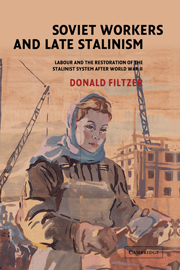 Soviet Workers and Late Stalinism
Soviet Workers and Late Stalinism Book contents
- Frontmatter
- Contents
- List of tables
- Preface and acknowledgements
- List of terms and abbreviations
- Introduction: the political imperatives of the postwar recovery
- 1 Rebuilding the workforce: free, slave, and indentured labour
- 2 The food crisis of 1946–1947
- 3 Attenuated recovery: the end of rationing, housing, and health
- 4 ‘Socializing’ the next generation: the position of young workers
- 5 Labour discipline and criminal law: the futility of repression
- 6 The industrial enterprise: working conditions, work organization, and wage determination
- Conclusion: labour and the ‘renormalization’ of Stalinist social relations
- Bibliography
- Index
3 - Attenuated recovery: the end of rationing, housing, and health
Published online by Cambridge University Press: 07 August 2009
- Frontmatter
- Contents
- List of tables
- Preface and acknowledgements
- List of terms and abbreviations
- Introduction: the political imperatives of the postwar recovery
- 1 Rebuilding the workforce: free, slave, and indentured labour
- 2 The food crisis of 1946–1947
- 3 Attenuated recovery: the end of rationing, housing, and health
- 4 ‘Socializing’ the next generation: the position of young workers
- 5 Labour discipline and criminal law: the futility of repression
- 6 The industrial enterprise: working conditions, work organization, and wage determination
- Conclusion: labour and the ‘renormalization’ of Stalinist social relations
- Bibliography
- Index
Summary
The end of rationing
Nineteen forty-seven marked the highpoint of the economic crisis and the social instability which it caused. In this sense we can say that 1948 was a turning point for the regime. With the harvest of 1947 food supplies began to improve. So, too, did the production of many basic consumer goods. Social tensions began to ease. Together these developments gave the regime the confidence to announce a far-reaching reform of the currency and the simultaneous end of rationing. The regime had wanted to abolish rationing as early as the end of 1946, but the harvest failure and ensuing famine had made this impossible. To move to open trade even at the close of 1947 was perhaps questionable from an economic point of view, but the regime calculated (almost certainly correctly) that such a policy would bring compensating political benefits by winning the approval of most of the non-agricultural population, at least in the largest cities. Economic liberalization did not, of course, mean that there would be accompanying steps towards political liberalization. On the contrary, 1948 saw an intensification rather than a relaxation of the political repression, which though aimed at selected groups, most notably the Jews and the intelligentsia, acted as a warning to the whole of society.
- Type
- Chapter
- Information
- Soviet Workers and Late StalinismLabour and the Restoration of the Stalinist System after World War II, pp. 77 - 116Publisher: Cambridge University PressPrint publication year: 2002


